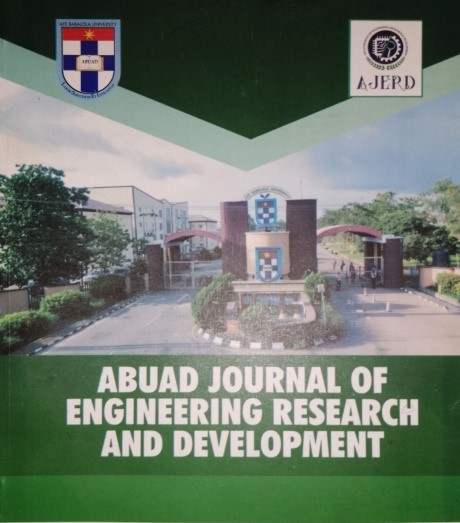Modelling and Simulation of Spray Pyrolytic Graphene and Graphite Coatings on Polymeric Substrates for enhanced Oil and Gas Pipeline Repair Applications
Main Article Content
Abstract
The oil and gas industry faces significant challenges in pipeline corrosion management, with high corrosion resistance and electrical conductivity for effective cathodic protection (CP). This study focuses on the mathematical modelling of electrical conductivity in nanoparticle-sized graphene, graphite, and graphene-graphite coated polyvinyl chloride (PVC) and glass reinforced polymer (GRP) substrates, prepared via low-temperature spray pyrolysis (50–60 °C). Single- and double-layer coatings with graphene-graphite blend ratios of 1:0.5 and 1:1 were applied on 50 × 10 × 2 mm substrates to obtain coating thickness of 0 µm, 56.1 µm, 77.2 µm, 80.6 µm, 80.8 µm, 92.6 µm, and 97.9 µm respectively for the PVC samples while the GRP samples have coating thickness of 0 µm, 110.3 µm, 114.0 µm, 109.0 µm, 115.7 µm, 117.3 µm, 124.7 µm. Electrical conductivity was measured using an LCR meter, and polynomial models were developed to correlate conductivity with coating thickness. Cathodic protection simulations assessed the performance of coated composites in a 15 km pipeline, highlighting the impact of non-conductive sections and the efficacy of bypass wire designs. Results showed that single-layer graphene-coated GRP achieved the highest conductivity (1.8 × 10⁻⁶ S/m), while double-layer hybrid coatings (1-0.5D) offered optimal durability. The mathematical models accurately predicted conductivity trends, with GRP exhibiting superior performance compared to PVC due to better graphene integration. CP modelling revealed that non-conductive GRP sections cause localized underprotection, mitigated by optimized bypass designs. These findings demonstrate that graphene-graphite-coated GRP composites, supported by predictive conductivity models and CP simulations, are promising alternatives to steel for pipeline repairs, enhancing corrosion control and longevity in oil and gas applications.
Downloads
Article Details

This work is licensed under a Creative Commons Attribution-NonCommercial-ShareAlike 4.0 International License.
References
Aird, M. (2019). Composite Pipes: A Breakthrough Technology for Offshore Drilling, Oilfield Technology, 71(4), 39-41.
Pavlou, D. G. (2013). Piping and Pipelines: Assessment Guide, Oxford, Elsevier.
Shamsuddoha, M., Al-Mahaidi, M. H. & Mutsuyoshi, K. (2013). Characterization of an Epoxy-Based Carbon Nanofiber Composite for Use in Concrete Structures, Composite Structures, 96, 471-480.
Berger, C. (2020). High Electrical Conductivity in Nickel-Tungsten Carbide Composite Electrodeposits, Electrochimica Acta, 342(136002).
Leotaud, C. (2018). Electroless Nickel Coatings. In Glenn, O. M., and Hajdu, J. B. Electroless Plating - Fundamentals and Applications, William Andrew Publishing.
Gordon, K.L., Das, L., Galhena, T.L., Gautam, M., King, G.C., Wiesner, V.L., Hernandez, J.J., Hodge, S.A., Wohl, C.J. (2024) Spray-deposition of graphene/polymer thin coatings on polyimide sheets for lunar dust adhesion mitigation, Acta Astronautica, 219, 449-458, https://doi.org/10.1016/j.actaastro.2024.02.030.
Ojemeni, K.I., Agunsoye, J.O., & Mgbemere, H.E. (2025). Spray pyrolytic layer modification of glass reinforced polymer substrate using graphene and graphite blend. International Journal of Current Research, 17(8), 34179-34190. https://journalcra.com/sites/default/files/issue-pdf/49315.pdf
Sathishkumar, T. P. & Jesuarockiam, G. (2014). Corrosion Resistant Glass Fiber Reinforced Thermoplastic Composite Pipes for Offshore Oil and Gas Industry Applications, Procedia Engineering, 64, 1314-1323.
Burger, N., Nguyen, X. C., Kuchler, M. & Eychmuller, A. (2016). In-Situ Formation of Gold Nanoparticles in a Conductive Polymer for Enhanced Electrochemical Sensing of Biomolecules, Advanced Functional Materials, 26(7), 1098-1106.
Deng, H., Zhang, G. & Xu, Y. (2014). Preparation and Electrical Conductivity of Carbon Fiber Reinforced Polymer Composites, Journal of Reinforced Plastics and Composites, 33(1), 58-64.
Yao, Z., Kang, J., Li, K., Yao, J. & Cheng, M. (2019). Preparation of Graphene Nanosheets and Their Electrical and Thermal Conductivities, Carbon, 53, 376-383.
Das, S. & Prusty, S. (2017). Investigation on the Flexural Behaviour of Graphene-Epoxy Nanocomposites, Materials Today: Proceedings, 4(2), 1890-1898.
Alemour, B., Ibnelwaleed, A., Abdullah, A. & Jamaludin, K. R. (2019). Properties Enhancement of Epoxy/Graphene Nanocomposites by Using Different Surface Treatment Techniques for Graphene Nanoplatelets, Composite Interfaces, 26(4), 339-361.




